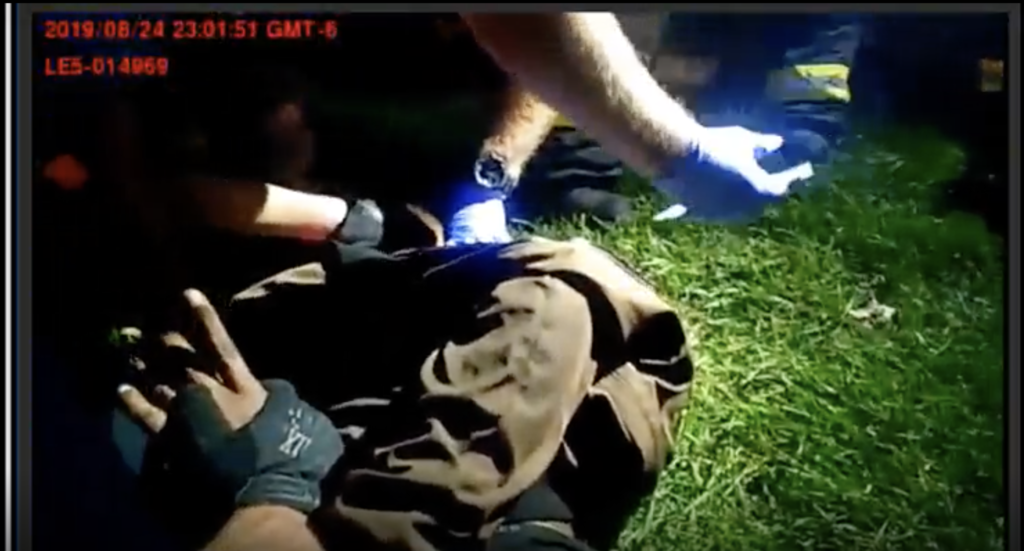Aurora Fire Rescue paramedic Jeremy Cooper stood above the slight 23-year-old man as he lay face down in the grass, a policeman’s knee in his back, wrists handcuffed and pulled high behind him.
For roughly six minutes, Cooper observed the man crying, gagging and calling out for help while being pinned face down by two officers. The paramedic asked no questions and performed no physical exam before deciding that the young man was suffering from “excited delirium” — a controversial term used to describe people displaying extremely agitated behavior.
“So, when the ambulance gets here,” Cooper can be heard saying on body camera footage, “we’re gonna go ahead and give him some ketamine.”
Within minutes, Cooper had administered enough of the powerful sedative to subdue someone almost 80 pounds heavier than the young man. Three days later, the massage therapist and self-proclaimed introvert was pronounced brain dead.
Elijah McClain’s death in Colorado in August 2019 occurred less than a year before the murder of George Floyd, which ignited a national reckoning on police because of their use of excessive force.
The coroner initially ruled that McClain’s death was due to “intense physical exertion and a narrow left coronary artery.” The office later amended that cause of death to too much ketamine – a change that wasn’t made public until September 2022, following three state and local investigations that found Aurora Fire paramedics had a history of illegally administering too much of the sedative without ever being held accountable by their superiors.
McClain’s parents filed a civil lawsuit against the police officers and paramedics involved in the death and settled with the city for $15 million. The five men were indicted for manslaughter, criminally negligent homicide and second-degree assault in September 2021.
A jury in October 2023 found one Aurora officer guilty of criminally negligent homicide for third-degree assault and another officer not guilty for his role in the death. A third officer was acquitted in November 2023.
Cooper and another paramedic were found guilty of criminally negligent homicide in December 2023. The other paramedic – convicted of an additional charge – was sentenced to five years in prison in March.
On Friday, Cooper was sentenced to four years’ probation.
“I am so sorry collectively that we failed you,” Cooper said during an emotional, two-hour sentencing hearing, referring to Elijah McClain.
McClain’s mother, Sheneen McClain, called Cooper an “accomplice to my son’s murder” and before a packed Colorado courtroom said, “eternal shame on you all.”

Lawyers for the paramedics did not respond to earlier emails or phone calls from Howard Center reporters seeking comment.
Dr. Steven Zeichner, the immediate past president of the Colorado Society of Anesthesiologists, said in his 35 years of practice he had never given a dose of ketamine as large as was administered to McClain.
“I’ve been doing this for a long time,” he told the Howard Center for Investigative Journalism. “I have never used even half that dose in patients larger [than McClain].”
A public records request for Cooper’s personnel records found he received positive performance reviews throughout his career. The city of Aurora said Cooper had no complaints, disciplinary actions or criminal accusations in his file.
Ketamine is not just a Colorado problem. Paramedics across the country use it to subdue agitated suspects during law enforcement encounters. Nearly 3,800 ketamine administrations were given for altered mental status or behavioral indications in 2019 alone, according to patient care records reported to ESO Solutions, a national EMS electronic health record system.
“I think perhaps, not only in Colorado, but across the country, we have become way too focused on a particular medication and not focused enough on the broader question,” Dr. Brent Myers, chief medical officer at ESO Solutions and past president of the National Association of EMS Physicians, said in an interview.
That broader question, according to Myers, is proper training to determine whether someone really requires sedation and how to correctly and safely administer it.
Looking ‘sketchy’
Police dispatchers received a call on the night of August 24, 2019, about a man wearing a ski mask who, according to the caller, “looked sketchy.” The responding officers worked for the city of Aurora, a large, middle-class suburb of Denver.
Two minutes after officers arrived and found McClain in a grassy area next to an apartment complex, they put him in carotid holds — in which an officer puts pressure on both sides of a person’s neck to induce unconsciousness. Police departments across the country, including Aurora’s, have since considered prohibiting carotid holds.
“Ow! Ow, that really hurt,” McClain cried out to officers as they handcuffed him. “You guys are very strong.”
Aurora Fire personnel arrived five minutes after officers radioed for backup, knowing only what they had been told by dispatchers: There was a “man running around in a mask … not making sense, waving his arms at cars and people,” they later told investigators.
Cooper said he was not told that McClain had been subjected to two carotid holds, nor that McClain had lost consciousness during the police encounter. He was informed, however, that McClain spoke English, but did not talk to or try to examine him.
“Whatever he’s on, he has incredible strength,” said one of the officers restraining McClain, who was 5 feet, 6 inches tall and 140 pounds.
Paramedics wheeled a gurney to McClain and, after confirming the amount of medication he would be giving, Cooper administered the dose of ketamine to McClain’s right shoulder.
Shortly after, McClain’s heart stopped beating. According to the paramedics’ patient care report, McClain had no pulse when he arrived at the hospital, despite efforts to resuscitate him.
“Simply put, this dosage of ketamine was too much for this individual and it resulted in an overdose,” Dr. Stephen J. Cina said in his autopsy report on McClain. “I believe Mr. McClain would most likely be alive but for the administration of ketamine.”
To justify giving McClain ketamine, Aurora Fire personnel and police officers claimed that he was hyper-aggressive and resisting arrest. However, a Howard Center review of the body camera footage released by the Aurora Police Department shows that McClain was not trying to fight or flee, and for almost an entire minute leading up to the ketamine administration, he did not move or make any sound.
Excited delirium was defined at the time by Colorado as “[a rare] medical emergency in which a person develops extreme agitation, aggressiveness, overheating, and exceptional strength that cannot be managed by routine physical or medical techniques.”
But, even today, there is no uniform definition for that term, and many leading professional medical organizations, including the American Medical Association, the World Health Organization and the American Psychiatric Association, do not recognize “excited delirium” as a legitimate medical condition. However, California became the first state in the nation in February 2023 to ban “excited delirium” from being recognized as a “valid medical diagnosis,” or from being used as a cause of death on autopsies and death certificates.
Exceeding maximum limits
Colorado Attorney General Phil Weiser appointed a team to investigate Aurora Fire Rescue and Aurora Police Department to determine whether any state or federal laws or statutes were violated in McClain’s death. The use of ketamine for “excited delirium” first began as a pilot program in Denver in 2013 and, by 2018, the Colorado Department of Public Health & Environment had authorized the program to expand across the state.
Investigators examined ketamine administration by Aurora Fire Rescue from January 2019 to September 2020 and discovered that paramedics were giving amounts of the medication that exceeded maximum limits and, in some instances, the sedative was given at the request of police officers without paramedics assessing the patient themselves.
Investigators concluded that Aurora Fire Rescue paramedics “had a pattern and practice of using ketamine in violation of the law” and that Cooper was not in compliance with EMS Education Standards because he didn’t examine McClain before giving him the fatal dose.
When “excited delirium” was listed as the reason for using ketamine, there was a noticeable lack of detail on the patient care reports paramedics are required to fill out, the Attorney General’s investigation also found.
By analyzing redacted patient care reports for these incidents, the investigation identified cases in which paramedics did not document the patient’s weight, and each time the weight was missing, the patient received the maximum dose permitted.
According to their report, one of the most concerning findings was although the weights were not recorded on the care reports, Aurora Fire reported weights for those patients to the Department of Public Health.
“For these patients, the reported weight was not always enough to justify the maximum dose given,” the report says. “And in five other instances, the weights listed in Aurora Fire’s care reports did not match the records they gave to the Department of Public Health.”
A lack of oversight by medical officials for Aurora Fire Rescue was also uncovered by the Attorney General’s investigation, specifically concerning the diagnosis of “excited delirium” and subsequent use of ketamine.
Not a medical emergency
Addressing the ketamine misconduct concerns, Colorado Gov. Jared Polis signed a law that took effect in 2021 preventing paramedics from using ketamine as a chemical restraint. The new law also defined excited delirium — and “any subsequent term for excited delirium” — as not being a medical emergency.
In addition to existing paramedic protocols, the law also added new directives regarding police officers at the scene. They are now prohibited from directing or otherwise influencing an Emergency Medical Service provider to administer ketamine.
“There will still be times when chemical restraint is still needed to assess, treat, and transport patients,” Polis said at the time. “But, that should only occur when patients… prevent EMS providers from safely assessing, treating, and transporting the[m] to a hospital, and not for matters relating to any criminal behavior or other circumstances not pertaining to the medical emergency.”
Ketamine has been singled out because of its increased use and law enforcement crises such as McClain’s death, but according to experts all such drugs carry risks.
“Ketamine seems to be a very good bogeyman,” said Dr. Desmond Wallington, the former Colorado mental health director for a clinic that uses the sedative to help patients with traditional talk therapy. He said the sedative works on a spectrum and is best used when those administering it have a clear understanding of the patient’s medical condition, something nearly impossible to do outside of a hospital setting.
Midazolam, or Versed, has been the sedative of choice for at least five years for Aurora Fire paramedics. But rapid decline in blood pressure and breathing difficulty are major risk factors when using Versed, especially in people with alcohol or other narcotics in their system.
With the risks Versed poses and without the use of ketamine, Aurora Fire Rescue’s protocols were updated in August 2022 to include a new sedative: Droperidol, which the Fire Department began using in early 2023.
Zeichner said eliminating ketamine completely would be a mistake. The key, he said, is ensuring each time a sedative is used there is proper evaluation of its use to ensure safety. In other words, the practices and protocols behind the administration of sedation are more pivotal than the medication itself.
“You’d be playing a game of whack-a-mole with whatever next drug is used,” he said. “All these drugs can cause respiratory depression.”
Reporter Taylor Stevens contributed to this story, which was produced by the Howard Center for Investigative Journalism at Arizona State University’s Walter Cronkite School of Journalism and Mass Communication. The Howard Center is an initiative of the Scripps Howard Fund in honor of the late news industry executive and pioneer Roy W. Howard. Contact us at howardcenter@asu.edu or on X (formerly Twitter) @HowardCenterASU.







